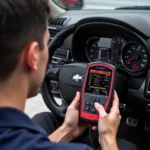OBD2 protocols are the standardized communication methods used by On-Board Diagnostics systems to transmit data between your car’s computer and a diagnostic tool, like an OBD2 scanner. Think of them as the language your car uses to tell you what’s going on under the hood.
Why are OBD2 Protocols Important?
Understanding the different OBD2 protocols is crucial for effective vehicle diagnostics. Using the correct protocol ensures seamless communication between your scanner and your car’s computer, allowing you to:
- Retrieve Diagnostic Trouble Codes (DTCs): Identify the specific issues triggering warning lights on your dashboard.
- Access Live Data Stream: Monitor real-time sensor readings like engine RPM, coolant temperature, and oxygen sensor voltage.
- Perform Advanced Functions: Depending on the scanner and protocol, you might be able to perform functions like resetting the check engine light, calibrating sensors, or activating specific components for testing.
A Deep Dive into OBD2 Protocols
There are five primary OBD2 protocols, each with its unique characteristics:
1. SAE J1850 PWM (Pulse Width Modulation)
- Primarily used in Ford vehicles.
- Features a single-wire communication system.
2. SAE J1850 VPW (Variable Pulse Width)
- Found in General Motors vehicles.
- Utilizes a single-wire communication system.
3. ISO 9141-2
- Common in European and Asian vehicles.
- Employs a two-wire communication system.
4. ISO 14230-4 KWP2000 (Keyword Protocol 2000)
- Widely adopted in newer European and Asian vehicles.
- Features a two-wire communication system.
5. ISO 15765-4 CAN (Controller Area Network)
- The most modern protocol, becoming increasingly prevalent in all vehicle makes.
- Uses a two-wire communication system and offers significantly faster data transfer rates compared to other protocols.
How to Determine Your Car’s OBD2 Protocol
- Check Your Owner’s Manual: The easiest way is to consult your car’s owner’s manual. It often lists the specific OBD2 protocol used.
- Inspect the OBD2 Port: The shape and pin configuration of your car’s OBD2 port can provide clues about the protocol used.
- Use an Automatic Protocol Detection Scanner: Most modern OBD2 scanners have an auto-detect feature that automatically identifies the vehicle’s protocol.
The Importance of Protocol Compatibility
Using an OBD2 scanner compatible with your car’s specific protocol is essential. Incompatibility can lead to:
- Inability to Establish Connection: The scanner might not be able to communicate with your car’s computer at all.
- Incomplete or Inaccurate Data: The scanner might retrieve partial or incorrect information, hindering accurate diagnosis.
Choosing the Right OBD2 Scanner for Your Needs
Consider the following factors when choosing an OBD2 scanner:
- Vehicle Compatibility: Ensure the scanner supports your car’s specific OBD2 protocol.
- Functionality: Determine the features you need, such as DTC reading, live data streaming, and advanced functions.
- User Friendliness: Look for a scanner with an intuitive interface and clear, concise data display.
- Budget: OBD2 scanners come in a wide price range, so choose one that fits your budget and requirements.
“Investing in a quality OBD2 scanner is crucial for any car owner or mechanic. It empowers you to take control of your vehicle’s diagnostics, saving you time, money, and potential headaches in the long run.” – John Smith, Senior Automotive Engineer at OBDFree
Conclusion
Understanding OBD2 protocols is paramount for effective vehicle diagnostics. By choosing the right OBD2 scanner and understanding the communication protocols involved, you can unlock a wealth of information about your car’s health, empowering you to make informed decisions about maintenance and repairs.
FAQs
1. Are all OBD2 scanners compatible with all protocols?
No, not all OBD2 scanners support all five protocols. It’s essential to check for compatibility before purchasing.
2. Can I use an OBD2 scanner designed for a different car make on my vehicle?
While it’s technically possible in some cases, it’s not recommended. Using a scanner incompatible with your car’s protocol can lead to communication errors and inaccurate data.
3. What is the difference between CAN and KWP2000 protocols?
CAN is a more modern protocol offering faster data transfer rates and greater bandwidth compared to KWP2000.
4. Do I need to know the specific OBD2 protocol to use a scanner?
Not necessarily. Most modern scanners have an auto-detect feature that automatically identifies the vehicle’s protocol.
5. Where can I find more information about OBD2 protocols and vehicle diagnostics?
OBDFree offers a wealth of resources and articles on OBD2 scanners, protocols, and vehicle diagnostics. Explore our website or contact our team of experts for personalized assistance.
Need help choosing the right OBD2 scanner? Contact us on WhatsApp: +1(641)206-8880, Email: [email protected]. Our 24/7 customer support team is here to assist you.

